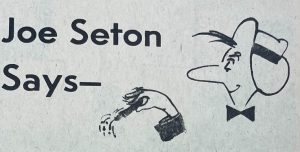Joe Seton Says: Ever The Contrarian

Who is Joe Seton? He started as a comic in the 1949 edition of The Setonian. He “was born in the imagination of Vahn Shirvanian, a member of the class of ’50.” Vahn became a successful cartoonist, at numerous points winning the National Cartoonist Society’s most outstanding honor for “Best Gag Cartoonist of the Year.”
But before that, he “drew a series of cartoons using Joe Seton as the main character and hero.” As The Setonian explains on Joe Seton’s 10th anniversary, “in these cartoons, fun was poked at everything and everyone,” including “registration difficulties, stickers on windshields, being late for class, and general student capers.”
After Shirvanian graduated, Joe Seton was last seen in the 1950 Galleon. However, in 1952, Joe Seton grew into a semi-regular column called “Joe Seton Says.” The Setonian called it “one of the most popular sections.” They even went as far as to say that this column “seems to be the first page that readers turn to.”
The column was “[all] at once informative, entertaining, and philosophical.” More apt descriptors would be satirical and paradoxical. Again, The Setonian notes, “since the mood of the column changes with the weather, so does student opinion.” Joe Seton will talk and mock just about anything.
For example, in one particular week, Joe Seton “took it upon himself to make a personal visit to the North Pole to interview Kris Kringle.” Joe Seton had wanted to know what Seton Hall was getting for Christmas. These columns could be silly chicanery like that. Other times it would be a mocking of the cafeteria food that week.
Throughout the 50s, there were a lot of these relatively harmless jokes. Occasionally, there would be more biting sarcasm. However, such sarcasm was reserved mainly for the student body. One such example mocks the idealistic nature of college students. In the column, Joe wrote about a hypothetical conversation between a student and a parent, where the student does not really have a plan on what they “are going to do after graduation.” This hypothetical student was to “join SANE and rid the world of nuclear weapons.” When pressed how he would support himself, the student replies, “By teaching volunteers for the Peace Corps.”
In an interview with Joe Seton’s creator Vahn Shirvanian in 1959, Shirvanian “pointed out one difference between Joe Seton of today and yesteryear: he now wears a tie.” In an ironic twist of foreshadowing, The Setonian editors “promptly told Vahn that Seton Hall is now a University and the administration insisted upon [formal wear].” It would be Joe Seton’s 1964 column, which mocked the University’s stringent dress code that got The Setonian suspended.
In the early 60s, there was a shift. The pointless and harmless comedy of the columns was increasingly replaced by the sardonic columns. One proposed “a cure for apathy.” Joe Seton discusses how he “started to think the other day (a Seton Hall first).” In Joe’s estimation, “the only cure [for apathy in student government elections] would be to have a Student King.” Such a king “would be appointed by the Bishop… and, of course, be a puppet leader.” Once again mocking the intellect of the student body, “the King would be guaranteed straight C grades (this is to raise him above the masses).” The obvious joke is that if the student body does not recognize and take advantage of their privileges to vote, such a privilege would be taken away.
Slowly, the receiver of Joe Seton’s scorn became the administration of the university. They had been targeted previously but for occasional, trivial matters like cafeteria food and problems with parking. In 1962, Joe Seton discussed how “the Administration seems to give the students an inch and then take two away.” In this column, he boldly states, “Just as Hitler took Poland, the minds and emotions of educated Setonians have been awayed” by the administration.
Under the Editor-in-Chief from 1963-64, Rocco Di Pietro, The Setonian was to “stress features.” They created a short-lived, similar column to Joe Seton Says in Marvin Moneywater, Campus Conservative. He played a similar character as Joe Seton but was staunchly more “conservative.” It was a bit redundant with Joe Seton’s existence, but now there were two columns which lampooned the administration, oftentimes week after week.
As mentioned in the cover story, Joe Seton’s column on the 20 February 1964 edition announced a satirical “Notice to All Students.” This column was the last straw. After weeks of mockery and what President Doughtery referred to as “an unwholesome spirit of cynicism,” Joe Seton, among other reasons, got The Setonian suspended.
It was the last time Joe Seton appeared as a regular column in The Setonian. He made brief appearances throughout the decade. However, he no longer was a staple of the newspaper. His words did not have the same punch. He was no longer as witty. The later half of the 1960s showed Joe Seton’s age. It’s funny; it’s almost as if he belonged to a bygone generation.
Joe Seton is best described as a contrarian. He made irreverent remarks that really amounted to nothing. He stirred the pot just to say he did. His column existed as a vehicle for The Setonian to vent their frustration of the week and drop it. However, Joe Seton does hold an important place in The Setonian history – specifically in the 60s.
